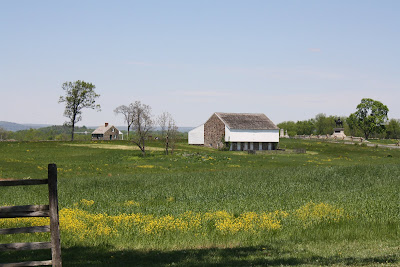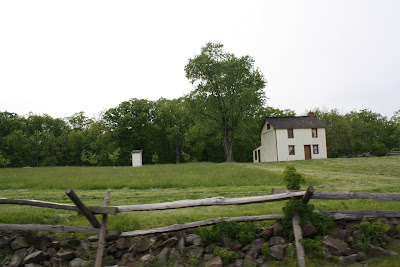 We headed out to the battlefield today. What a sad place.
We headed out to the battlefield today. What a sad place.The park began in 1864 by veterans and interested persons. The first regimental monument was erected by Massachusetts in 1879 and many states and regiments followed suit. The entire park was transferred to the US Government in 1895 and it now covers several thousand acres.
It began as a skirmish but by its end involved 160,000 Americans.
The Battle of Gettysburg was fought from Wednesday, July 1st until Friday, July 3rd in 1863. The armies remained facing each other on the field on July 4th and there was minor skirmishing, although it is not usually considered part of the battle.
Those numbers don't include civilian teamsters, servants, slaves and other camp followers. Around 2,500 civilians were also in the battle area.The Confederate
70,000 men commanded by General Robert E. Lee
The Union
94,000 men commanded by Major General George G. Meade
Losses for the:
Union Army
3,155 killed 14,525 wounded 5,365 missing/captured
Confederate Army
(causality records were seldom accurate and often never reported) reasonably accurate report is:
2,632 killed 12,809 wounded 5,247 missing/captured
 Peace Light Memorial It was dedicated in 1938 by President Roosevelt in a 75th anniversary service attended by more than 1800 Civil War veterans. The flame is fed by natural gas.
Peace Light Memorial It was dedicated in 1938 by President Roosevelt in a 75th anniversary service attended by more than 1800 Civil War veterans. The flame is fed by natural gas. The battlefield is all the way to the ridges and knolls across the way. The railroad cut is were one of Davis' Confederate Brigade sought cover only to be trapped. Over 200 we captured.
The battlefield is all the way to the ridges and knolls across the way. The railroad cut is were one of Davis' Confederate Brigade sought cover only to be trapped. Over 200 we captured. The story goes that the battle was so furious and the bullets and cannon firer so massive that the trees were cut down. During one of the battle a soldier saw that a robin's nest had been knocked out of a tree. He stopped and put the nest back in the tree.
The story goes that the battle was so furious and the bullets and cannon firer so massive that the trees were cut down. During one of the battle a soldier saw that a robin's nest had been knocked out of a tree. He stopped and put the nest back in the tree.  More of the battle field with the flowers honoring the fallen soldiers. They say that some of the battles here were so bloody that you could walk from one side of the field to the other and not touch the ground because of all the fallen bodies.
More of the battle field with the flowers honoring the fallen soldiers. They say that some of the battles here were so bloody that you could walk from one side of the field to the other and not touch the ground because of all the fallen bodies.  There were 600 cannons here in Gettysburg during the battle. The have 400 here now representing the location and direction they would have been at the time. This cannon was called a 12-pounder and 40% of the cannons were of this type. Loaded in the front and could shot up to a mile.
There were 600 cannons here in Gettysburg during the battle. The have 400 here now representing the location and direction they would have been at the time. This cannon was called a 12-pounder and 40% of the cannons were of this type. Loaded in the front and could shot up to a mile. Rifle cannon. Loaded in the back and increased the range up to 5 miles. The North did not have any of this kind of cannon.
Rifle cannon. Loaded in the back and increased the range up to 5 miles. The North did not have any of this kind of cannon. North Carolina had the most men participate in this battle and also sustained the most losses in this battle of any one state. It was sculptured by Gutzon Borglum of Mount Rushmore fame. Mount Rushmore is located in South Dakota where I was raised. It was dedicated in 1929.
North Carolina had the most men participate in this battle and also sustained the most losses in this battle of any one state. It was sculptured by Gutzon Borglum of Mount Rushmore fame. Mount Rushmore is located in South Dakota where I was raised. It was dedicated in 1929.  Virginia Memorial dedicated in 1917. It includes a statue of General Lee on his horse Traveller. It should be noted that General Lee is the only Confederate officer with a statue.
Virginia Memorial dedicated in 1917. It includes a statue of General Lee on his horse Traveller. It should be noted that General Lee is the only Confederate officer with a statue.  There were many farms on the battle field too then and they are there now and forever.
There were many farms on the battle field too then and they are there now and forever. More monuments on the battle field. The terrain is different the fighting is different.
More monuments on the battle field. The terrain is different the fighting is different.  This is New York's Monument. There is a spot for the statue of Maj. General Sickles, but it was never placed there. No one is for certain, but they believe the General Sickles stole the money that was to be used for the statue. He was not a well liked or honest man in politics or the battle field.
This is New York's Monument. There is a spot for the statue of Maj. General Sickles, but it was never placed there. No one is for certain, but they believe the General Sickles stole the money that was to be used for the statue. He was not a well liked or honest man in politics or the battle field.  The statue to honor Father Corby was placed on the battlefield in 1910. It depicts the father at the moment of pronouncing absolution to the men of the Irish Brigade.
The statue to honor Father Corby was placed on the battlefield in 1910. It depicts the father at the moment of pronouncing absolution to the men of the Irish Brigade.  The Pennsylvania
The Pennsylvania State Memorial was dedicated in 1910. The monument is meant to honor all the Pennsylvanians who participated in the campaign. Standing atop the dome is the Goddess of Victory and Peace. Actual Civil War cannons were melted down and used to made the figure.
 Another small farm house with the little house out back.
Another small farm house with the little house out back.  There are many ways to tour the battlefield. We did a car tour with book and CD, you can hire a guide and he takes you around and gives you a personal tour, go on a bus with headsets or personal tour guide. Or we spotted this group on horseback with a tour guide.
There are many ways to tour the battlefield. We did a car tour with book and CD, you can hire a guide and he takes you around and gives you a personal tour, go on a bus with headsets or personal tour guide. Or we spotted this group on horseback with a tour guide. Downtown historical Gettysburg. These building were here during the battle. It was amazing that with all the soldiers marching all around and in town that only one civilian was killed. It was Jennie Wade. She was baking bread for Union troops when a stray bullet pierced two wooden doors and killed her. She was in town at her sister's home when it happened.
Downtown historical Gettysburg. These building were here during the battle. It was amazing that with all the soldiers marching all around and in town that only one civilian was killed. It was Jennie Wade. She was baking bread for Union troops when a stray bullet pierced two wooden doors and killed her. She was in town at her sister's home when it happened. On November 19, President Lincoln went to the battlefield to dedicate it as a military cemetery. The main orator, Edward Everett of Massachusetts, delivered a two hour formal address. The president then had his turn. He spoke in his high, penetrating voice and in a little over two minutes delivered the Gettysburg Address, surprising many in the audience by its shortness and leaving others quite unimpressed.
Over time, however, the speech and its words - government of the People, by the People, for the People - have come to symbolize the definition of democracy itself.
 I thought this was cute.
I thought this was cute. As we drove around and walked the battlefield I was struck with what had happened here so many years ago. The terror that all must have felt, soldier and town folk alike, as the fighting raged on. I hope we can learn of all this.











No comments:
Post a Comment